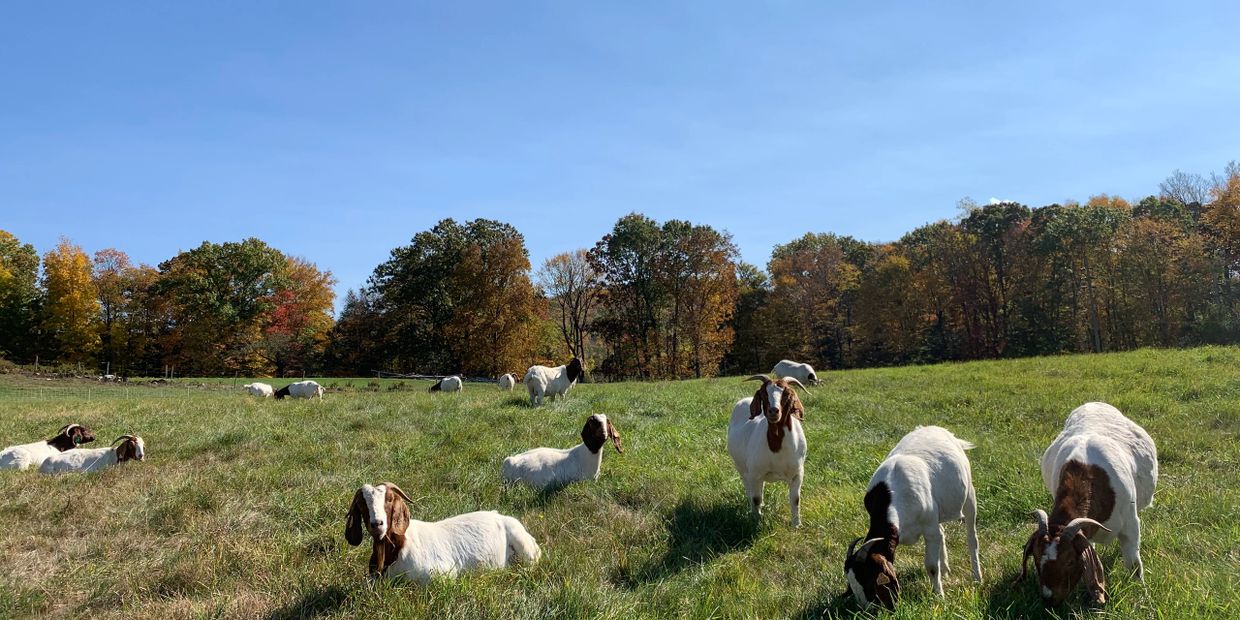
Internal Parasite Management
In raising goats on pasture, one of the greatest challenges is internal parasites that result in unthrifty, poor-doing, thin, or anemic animals. Goats are routinely exposed to a variety of internal parasites, but the most devastating is haemonchus contortus, commonly known as the barber pole worm.
In general, some level of parasitism is expected in any grazing animal, and isn't necessarily detrimental. When the parasite population gets too large, however, the goat will start to suffer ill effects in the form of a rough coat, decreased productivity and growth, poor feed conversion, diarrhea, anemia and even death in severe cases.
Our goal is to maintain optimal animal health and performance, while minimizing the anthelmintics (chemical dewormers) we administer. These are a few of the things we do to reduce our use of anthelmintics:
- Maintain a rigorous quarantine procedure, including fecal egg count reduction testing, to minimize incoming parasites that may be resistant to our currently effective anthelmintics
- Utilize management techniques such as intensive rotational grazing and encouraging browsing to minimize exposure to infective stage parasite larvae
- Ensure the more susceptible animals (heavily pregnant and nursing does, young kids, etc.) are receiving enough protein and energy in their diet to optimize their immune response to internal parasites
- Maintain adequate mineral levels through a mineral supplement formulated for meat goats, as well as administering copper boluses, which have been shown to have an anti-parasitic effect
- Use the same class of anthelmintic for as long as it is working, reserving the most effective drugs for emergency situations, to slow the development of anthelmintic resistance in our resident parasites population
- Deworm based on need (determined using FAMACHA, fecal egg counts, and body condition scoring), NOT on a "schedule"
- Only deworm the animals that display a need, not all animals at the same time
- Determine accurate animal weights and effective anthelmintic dosages to ensure any treatments are as effective as possible
- Cull animals who continually require treatment when others do not
Learn More
The American Consortium for Small Ruminant Parasite Control (ACSRPC) is a leader in research and education in parasite control in small ruminants. The ACSRPC was was formed in 2003 in response to the critical state of the small ruminant industry associated with the emergence of anthelmintic resistant worms. They work to develop methods for sustainable control of gastrointestinal parasites in small ruminants and share the most up-to-date methods and guidelines for management of gastrointestinal parasites.
External Parasites
Lice
Mites
Mites
Lice are small parasites that live on the skin and hair of the goat. They are species-specific, so there is no need to worry about "catching" lice from your goats. There are two types of lice: biting lice and sucking lice.
Biting lice feed on debris around the hair follicle on the animal they are parasitizing. They generally don't cause direct health concerns, instead resulting in itching, agitation and the classic swirls around the animal's coat from scratching. They are effectively treated with a topical product.
Sucking lice feed on blood and can cause anemia if not treated. They are killed by a topical treatment or a targeted internal antiparasitic, like injectable Ivermectin.
Since determining the type of lice is often difficult, any signs of lice on our goats are treated with a topical treatment. Synergized De-Lice or a similar product has been our preference, as it is oil-based, lasts for 10 days, and kills both types of lice. We repeat the application 10-14 days after the first treatment to kill any lice that have hatched since the first treatment.
If there are signs of lice on any of our goats, the entire herd is treated, since all are very likely to have them. Treating only a portion of the herd will simply cause the lice to jump ship to the nearest un-treated host.
Mites
Mites
Mites
Mites are microscopic parasites that burrow into the skin of their host. On goats, they are typically found on the lower legs and around the eyes, mouth and ears. They will cause scabs or generalized hair loss, usually on all four legs and/or symmetrically on the face.
Topical treatments are generally not effective, as the mites encapsulate themselves inside the animal's skin, where topical treatments will not penetrate. Injectable Ivermectin is effective in the treatment of mites, but must be given every 10-14 days to kill the adult mites as well as the hatchlings as they emerge.
Some goats will develop a localized secondary infection from the damage the mites do as they burrow into the skin. Usually, a round of Penicillin along with treatment for the mites works quite well.
Another interesting thing to note with mites is that there is often one animal who seems particularly bothered by mites, while others are unaffected. There are theories that there is a difference in the immune response that causes some animals to be a better host for mites. The practical message is that treating the animal displaying the symptoms of infection is usually sufficient to clear up the problem and there usually is no need to treat the whole herd.
Oak Hollow Livestock
Shelburne, Massachusetts, United States

Email Newsletter
Would you like to be the first to find out what's happening on the farm? Sign up for our newsletter to get updates from us in your email!